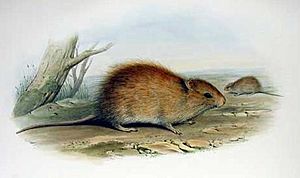Australian swamp rat facts for kids
Quick facts for kids Australian swamp rat |
|
|---|---|
 |
|
| Conservation status | |
| Scientific classification | |
| Genus: |
Rattus
|
| Species: |
lutreolus
|
The Australian swamp rat (Rattus lutreolus), also known as the eastern swamp rat, is a type of rat that lives along the coasts of southern and eastern Australia. These rats are well-adapted to wet, marshy places.
Contents
What Does the Swamp Rat Look Like?
The Australian swamp rat is a sturdy little animal. Its body grows to about 160 millimeters (6.3 inches) long. Its tail is a bit shorter, around 110 millimeters (4.3 inches). These rats usually weigh about 120 grams (4.2 ounces).
They have dark brown or black fur and black feet. Their belly fur can be cream or light brown. They have small ears that are almost hidden by their fur. Their tail is dark grey, scaly, and doesn't have much hair.
Where Do Swamp Rats Live?
The swamp rat lives near the coast in southern and eastern Australia. You can find them in low-lying areas from Fraser Island down the coast through New South Wales and Victoria. They also live in the Mount Lofty Ranges in South Australia.
A special type of swamp rat, called velutinus, lives in Tasmania. Another type, lacus, lives in small, high-up areas of rainforest near Atherton, Queensland.
Swamp Rat Homes
Swamp rats love to live in thick vegetation near water, like in swamps or along rivers. They also like dense plants on islands that are above the high water mark. You might also find them in coastal heathlands, sandy dune areas, grasslands, and areas with sedges.
These rats create tunnels through the thick plants. These tunnels help them move around easily. They choose their homes based on how dense the plants are. Areas that often have fires are usually not re-settled by swamp rats. You can sometimes spot them at places like the Healesville Sanctuary, where they live freely on the grounds.
What Do Swamp Rats Eat?
Australian swamp rats are mostly vegetarian. They eat things like reeds, seeds, and the stems of swamp grasses.
In the summer, they eat more insects and fungi. But in the spring, they switch to eating more seeds. This is because seeds are plentiful then and might give them extra nutrients for breeding.
How Do Swamp Rats Behave?
When Are Swamp Rats Active?
Swamp rats are active both during the day and at night. This means they are partly nocturnal (active at night) and partly diurnal (active during the day). Scientists think they might not find enough food at night, so they also need to gather plants during the day.
Swamp Rat Families and Safety
Swamp rats usually become old enough to have babies around August. They start breeding in October. A mother swamp rat can have anywhere from one to eleven babies in a litter. Her pregnancy lasts about 23 to 25 days.
Swamp rats use their strong sense of smell to detect predators. They can smell the unique scents of other animals, which helps them stay safe.
See also
 In Spanish: Rata australiana de pantano para niños
In Spanish: Rata australiana de pantano para niños


